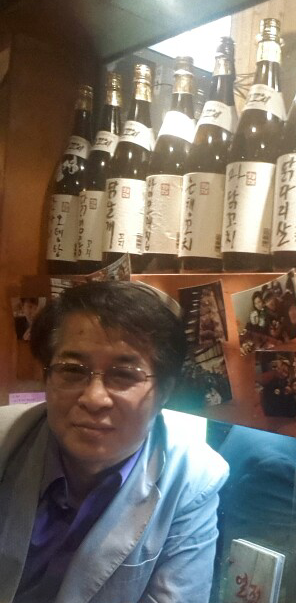[동영상 강의 유튜브 연우리 영어] → https://youtu.be/wCbhOFyB4V0
[PT17-1]0641. [명지대학교 2006-1]
With the road ____________ by the fallen tree, we had to make a detour.
(A) blocking (B) to block (C) blocked (D) have blocked
[PT17-1]0641. ['with 구문'의 능동과 수동]
정답 - C : 'With the road' 다음에 길이 막힘을 당하는 것이므로 과거 분사가 따라야 한다.
[해석] 길이 쓰러진 나무에 의해 막혀 있어서 우리는 우회를 해야만 했다.
[PT17-2]0642. [세종대학교 2008-1]
The system runs (A)[as] a stand-alone application (B)[with] data (C)[downloading] from (D)[an] IBM host.
[PT17-2]0642. ['with 구문'의 능동과 수동]
정답 - C : [downloading] → [downloaded] : ‘다운로드된’의 의미이므로 수동 의미인 과거 분사를 써야 한다.
[해석] 이 시스템은 자료가 IBM 중앙 컴퓨터에서 다운로드되는 독립형 애플리케이션으로 작동한다.
[PT17-3]0643. [전남대학교 2007-1]
(A)[With] implants (B)[inserting] through the armpit, breast (C)[augmentation] usually (D)[leaves] only a small scar.
[PT17-3]0643. ['with 구문'의 능동과 수동]
정답 - B : [inserting] → [inserted] : 'with 구문'에서 의미상의 주어인 임플란트는 삽입되는 것이므로 수동인 과거 분사가 쓰여야 한다.
[해석] 보형물이 겨드랑이를 통해 삽입되므로 가슴확대수술은 보통 작은 흉터만을 남긴다.
[PT17-4]0644. [울산대학교 2003-1]
I'll never forget the day _________ I first met him.
(A) where (B) what (C) when (D) Who
[PT17-4]0644. [관계 부사]
정답 - C : 선행사가 'the day'이므로 관계 부사는 'when'을 사용한다.
[해석] 내가 처음으로 그를 만났던 날을 나는 결코 잊지 못할 것이다.
[PT17-5]0645. [명지대학교 2012]
다음 중 어법상 적절하지 못한 것은?
(A) If the president had not lost the vote on the budget reduction package, the Administration's first year in office would have been rated A.
(B) One of my students in the class was a woman who wanted to write about the house in Jeju Island there she grew up.
(C) In the 19th century, a new means of communication was developed — the railway.
(D) In a co-publication agreement, ownership of both the material and its means of distribution is equally shared by the parties.
[PT17-5]0645. ['there'와 'where']
정답 - B : [there] → [where] : 두 개의 절이 연결되기 위해서는 'there'가 관계 부사인 'where'로 바뀌어야 한다.
A : 가정법 과거 완료
C : 'means'는 단수와 복수가 동형으로 'means'이다.
[어휘] package : (제안·계획·법안 등의) 일괄, 하나로 묶음 agreement : 계약, 협정; 동의, 합의
rate A (as) B : A를 B라고 여기다, 간주하다 means of distribution : 유통(기구), 판매망
communication : 교통; 교통수단[기관] a means of communication : 교통 기관[수단]
[해석] B : 제 클래스의 학생들 중 한 명은 자신이 자란 제주도의 집에 대해 글을 쓰기를 원하는 여성이다.
[PT17-6]0646. [명지대학교 2011]
(A)[The period] in American history (B)[during when] the (C)[sale of] alcohol (D)[was banned] was called Prohibition.
[PT17-6]0646. [전치사 뒤의 관계 대명사]
정답 - C : [during when] → [during which] : 선행사가 'period' 지만 'during'이 전치사이므로 관계 부사가 아니고 관계 대명사가 따라야 한다.
D : 'was'의 주어는 'the sale'이다.
[해석] 미국사에서 술의 판매가 금지되었던 기간은 금주법 시대라고 불렸다.
[PT17-7]0647. [세종대학교 2011]
________________ you can't talk right.
(A) The reason you can't get a job is because
(B) The reason for you can't get a job is because
(C) The reason for you can't get a job is because of
(D) The reason you can't get a job is because of
[PT17-7]0647. [관계 부사]
정답 - A : 'the reason' 다음에는 'that'이나 'why'는 생략될 수 있다. 'because'보다는 'that'을 쓰는 것이 더 좋지만 회화체에서 흔히 'because'를 쓰기도 한다.
B, C : 'for you(의미상의 주어)'에서 'you'는 목적격이므로 뒤에 정동사인 "can't"가 따를 수 없다.
D : 'because of' 다음에 절이 따를 수 없다.
[해석] 네가 일자리를 얻지 못하는 이유는 정확하게 말을 할 줄 몰라서이다.
[PT17-8]0648. [대구대학교 2009]
Painting is always focused on color and the manner ( ) color is employed to a two or three dimensional surface to illustrate or imitate a scene, person, or object.
(A) which (B) how (C) in which (D) whose
[PT17-8]0648. [관계 부사]
정답 - C : 선행사가 'manner'이므로 'in the manner'에서 'in which'로 전환되어야 한다.
B : 'the manner how'는 'the way how'와 마찬가지로 중복적인 표현이다.
[해석] 회화는 항상 색에 초점을 두며 장소나 사람이나 물체를 이차원이나 삼차원의 표면에 색을 사용하는 방식에도 초점을 둔다.
'편입 문법 3000 Plus' 카테고리의 다른 글
| 편입 문법 3,000제+ 강의 [115회] (0) | 2021.01.09 |
|---|---|
| 편입 문법 3,000제+ 강의 [114회] (0) | 2021.01.09 |
| 편입 문법 3,000제+ 강의 [112회] (0) | 2021.01.09 |
| 편입 문법 3,000제+ 강의 [111회] (0) | 2021.01.09 |
| 편입 문법 3,000제+ 강의 [110회] (0) | 2021.01.08 |
